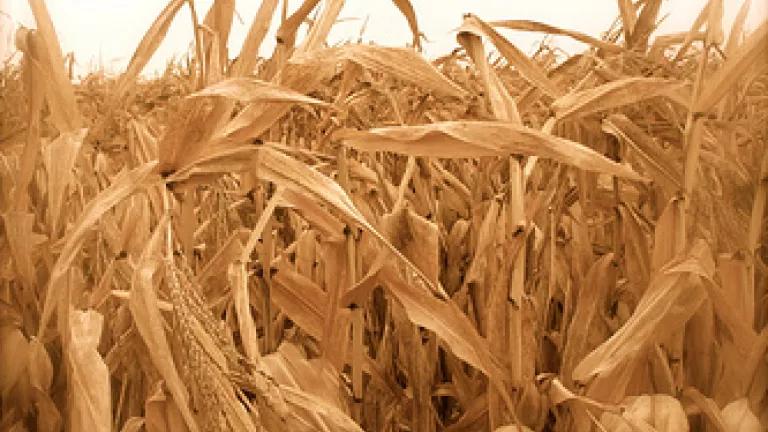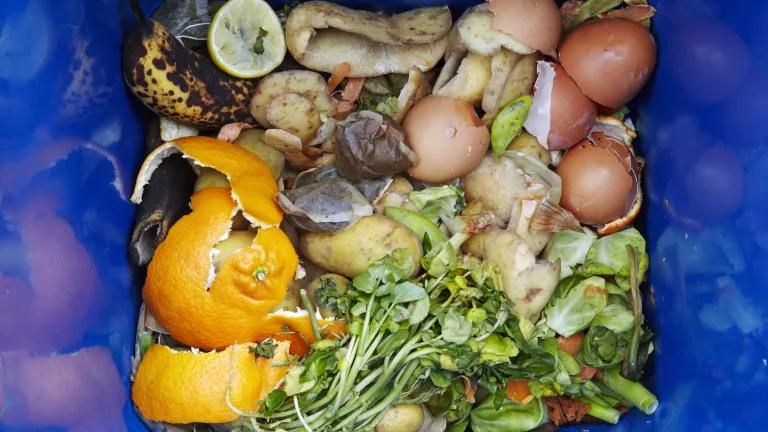
Impact of drought on crop field in Illinois
Photo credit: velo_city
This guest post is by Fay Augustyn, conservation associate at American Rivers, as part of a blog series for Getting Climate Smart, a joint effort by NRDC and American Rivers to guide state action on climate and water preparedness.
Please join us for a one-hour webinar on May 14 at 3pm EDT, where we’ll provide highlights from our new guide and state officials from California and Massachusetts will share about their climate preparedness planning and implementation experiences.
Agriculture is part of the bedrock of American life. It provides food for our tables, jobs for our citizens, and it supports a significant chunk of our economy. U.S. agricultural exports alone generate more than $100 billion annually in business activity in the U.S., and provide jobs for nearly one million workers.
Agriculture is also the biggest consumer of U.S. water resources, accounting for over 80% of the nation’s consumptive water use. Last September, the U.S. Department of Agriculture designated over 2,000 U.S. counties as disaster areas due to drought. It was (and is) the most severe and extensive drought in the last 25 years, destroying portions of corn and soybean crops across the Midwest, causing a ripple effect on the price of food and affecting communities across America. The most recent data illustrates that the drought and heat from 2012 caused $16 billion in crop insurance indemnities for 2012. While we aren’t sure what the coming summer has in store for us, we do know that snowpack in many western states is less than the norm, which will likely reduce the amount of water available for agriculture.
In addition to the concerns around the effects of drought on agriculture, the severe storms and flooding that have become the norm are also likely to cause serious impacts to the agricultural sector. The current floods in the Midwest have delayed the planting of many crops, and may also impact the types of crops that can be planted. These types of storms and flood events are projected to increase in the future.
Last week, we released Getting Climate Smart, (see my previous post here) an easy-to-use guide to help states and cities prepare for the impacts of climate change. In a time of climate uncertainty, when we are unsure what will hit us next, it is critical to be prepared for all potential impacts to water resources and the sectors that depend on them. Too much water? Too little water? Both of these scenarios affect agriculture adversely. Getting Climate Smart outlines numerous “no regret” strategies to reduce dependence on increasingly limited supplies and help all farmers manage water-related stresses. Many of these practices are already in use and producing results.
For example, in Sonoma County, California, recycled water is a routine part of the water system. In the past, recycled water was used primarily for landscape irrigation but, over the last ten years as demand significantly increased, the county responded by increasing the treatment level of wastewater, making it suitable for agricultural production. Now recycled water irrigates approximately 6,000 acres of farmland including dairy, vineyards, and row crops. Based on this success, Sonoma County proposed the North Sonoma County Agricultural Reuse project, which would provide recycled water to an additional 21,100 acres of existing agricultural land.
In addition to using recycled water to help address agricultural water needs, there are many other strategies that farmers and the state can implement to make agricultural practices more resilient in the face of a changing climate:
- Reduce water loss in existing irrigation systems through maintenance and repair;
- Plant a variety of crops, including those that are less water intensive and hard on the soil, to reduce water consumption and defend against drought;
- Use buffer strips of riparian vegetation to slow bank erosion and filter drainage from fields;
- Incentivize conservation best management practices (e.g., conservation planning) by offering reduced agricultural insurance (crop/ index-based) rates; and
- Use voluntary floodplain corridor protection easements on agricultural lands to maintain production and reduce impacts of floods.
We all rely on farmers, ranchers and their supply chains to put food on our tables. However, as the prospect of more frequent and extreme weather events across the U.S. increases and population continues to rise, the challenges associated with agriculture and water will force us to find new ways to secure reliable clean water supplies. While we can’t make it predictably and reliably rain, we can manage the water we do have in ways that make our communities and rivers more resilient in the face of more frequent extreme weather events.



